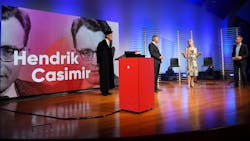New Dutch institute to focus on next-gen photonics and quantum technology
Recognizing that photonics and quantum technologies are needed to further computational power and energy-efficient communication, the Eindhoven University of Technology (TU/e; Eindhoven, Netherlands) has established a new institute to create a unique and optimal environment to enable these fields to grow synergetically. The new institute, named the Eindhoven Hendrik Casimir Institute (EHCI), was officially launched on September 6, 2021, by Robbert Dijkgraaf during the opening of the academic year.
The EHCI is named after Dutch physicist Hendrik Casimir (1909 – 2000), who is most famous for his work on superconductivity and quantum physics, most notably the Casimir effect—the phenomenon where two plates placed very close to each other subtly attract each other due to quantum fluctuations. This is analogous to how the two research fields underpinning the institute will be working close together.
The new institute will smartly ‘entangle’ two major technology fields: the superfast light-driven communication technology of photonics and the powerful calculation capabilities of quantum technology. These technology fields hold great promise in overcoming the limits that current computation and communication technologies are slowly but surely reaching—for example, in terms of miniaturization and energy costs.
Both technologies are world-class in Eindhoven, illustrated by recent multimillion funds from the PhotonDelta and Groeifonds projects. The work at EHCI will be done at various hierarchical levels, from groundbreaking science in materials, via novel devices and innovative circuits, to disruptive systems that will shape our future world. This approach, already applied at TU/e to bring integrated photonics technology from the lab to real-world applications, will also be used for quantum technology and other emerging information technologies.
“In 10 years’ time, the institute will make significant contributions to new computing paradigms like quantum and neuromorphic computing, to novel technologies to make communication far more energy-efficient and secure and to compact biosensors for detecting diseases, and metrology sensors with atomic-scale resolution,” says Martijn Heck, scientific director of the EHCI.
Sources: Eindhoven University of Technology and Science Business press releases
